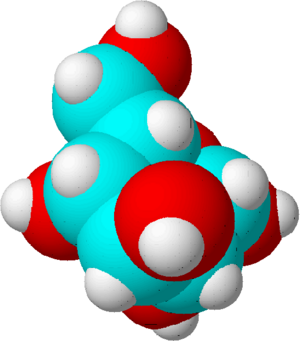Molecule facts for kids

A molecule is the smallest amount of a chemical substance that can exist by itself. Think of it as the tiniest building block of something like water or sugar. If you split a molecule into smaller pieces, it would become a different substance entirely.
Molecules are made up of tiny parts called atoms. These atoms stick together in a specific way, like LEGO bricks forming a particular shape. Not all combinations of atoms are possible. Atoms prefer to make certain shapes and connections. For example, an oxygen atom usually connects to two other atoms, a carbon atom connects to four, and a nitrogen atom connects to three.
In gases like the air we breathe, molecules are mostly flying around freely. In liquids like water, molecules are stuck together but can still slide past each other. In solids like sugar, molecules are held tightly in place and can only vibrate a little. There's also a fourth state of matter called plasma, where atoms are so hot they break apart and can't form molecules.
We can describe molecules using a molecular formula. This formula tells us how many of each type of atom are in a molecule. For example, the molecular formula for glucose (a type of sugar) is C6H12O6. This means one molecule of glucose has six carbon atoms, twelve hydrogen atoms, and six oxygen atoms.
How Molecules Stick Together (Bonding)
For a molecule to exist, its atoms have to stick together. This happens when two atoms share tiny particles called electrons. Instead of an electron circling just one atom, it starts circling around both atoms. This special connection is called a covalent bond.
Sometimes, atoms share more than one electron. The more electrons they share, the stronger the bond becomes, and the tighter the atoms stick together.
Bonds can also be broken apart. When most bonds form, they use up energy. But when they break, they can release energy. To break a bond, you usually need to add some energy first, often by heating the molecule. When atoms get too hot, they move around a lot, and their bonds can snap.
Molecules that release more energy when their bonds break than the energy needed to start the breaking process are called fuels. Think about a candle: it just sits there until you light it with a match. The match provides the first bit of energy to break some bonds in the candle wax. This breaking releases enough energy to break more bonds, and so on, keeping the candle burning for a long time.
There are also other ways atoms can stick together, like ionic bonds, which involve atoms giving or taking electrons instead of sharing them.
Images for kids
-
An AFM image of a PTCDA molecule. You can see its five six-carbon rings.
-
A scanning tunneling microscopy image of pentacene molecules. These are long chains of five carbon rings.
-
The structure and a STM image of a "cyanostar" dendrimer molecule.
-
Hydrogen can be taken off H2TPP molecules using a scanning tunneling microscope (STM, a). This changes how the molecules conduct electricity (b). Image (c) shows a line of TPP, H2TPP, and TPP molecules. In image (d), hydrogen was removed from H2TPP at the black dot, as seen in the bottom part of (d) and in image (e). These kinds of changes can be used in single-molecule electronics.
See also
 In Spanish: Molécula para niños
In Spanish: Molécula para niños






